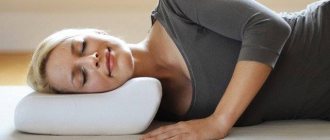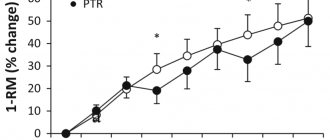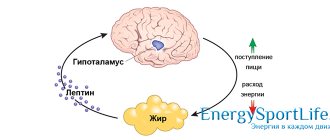Home » Health » How to get rid of sore throat
All sports fans are familiar with this feeling of muscle stiffness after training, but not everyone knows how to get rid of soreness. This problem, to one degree or another, worries almost all people leading an active lifestyle, and it is associated with significant stress on the muscles. Krepatura is often associated with strenuous exercise in the gym, which is why it is called muscle pain after training. In fact, the problem is much broader. In addition to people who are passionate about sports, the question of how to get rid of muscle soreness can affect many people if they have certain pathologies.
Muscle soreness affects not only athletes
DOMS under a microscope
Muscle pain comes in different forms and not all of it is soreness.
So, during intense exercise for a large number of repetitions, you can feel a burning sensation in the muscles - this is the effect of lactate or lactic acid, which has nothing directly to do with DOMS. 20–40 minutes after physical activity, the lactate level returns to normal, so its effect on the muscles is out of the question after a day or two.
A pleasant nagging pain and fatigue immediately after an effective workout is also not a sore throat, but only a momentary response of the body to stress.
Severe and sharp pain when moving and persistent aching when the strained muscle is at rest may indicate an injury. Especially if the pain increases significantly with exercise and does not disappear after several repetitions or the second or third approach.
But when pain occurs 24–48 hours after physical activity, it is felt when the muscle is working, but does not bother you when it is at rest - this is classic sore throat .
Depending on the muscle group, training and stress received during training or any other physical activity, the painful state of the muscles can persist from a couple of days to a week. That is, you can, in principle, do nothing about the soreness, but just endure the pain and it will go away on its own. Or you don’t have to endure it, but we’ll talk about that a little later.
Why does delayed onset muscle pain syndrome occur ? For a long time it was believed that lactic acid, formed during anaerobic exercise, was to blame. But, as I mentioned above, and what has been proven by scientists, this is not the cause of sore throat. Within an hour, lactate levels return to normal. Although back in 1902, the phenomenon of DOMS or “muscle fever” was described by Theodore Hough, explaining it by the rupture of muscle fibers that occurs during intense physical activity. He turned out to be closest to the truth.
Now there are two relevant theories that complement each other.
The first is that soreness is the result of micro-tears of muscle fibers. The trauma is minimal to seriously excite the nervous system, but sufficient that over time the pain receptors inside the muscle connective tissue begin to react, causing those very unpleasant sensations when muscles are tense. Let me remind you that at rest there is no pain.
The second theory is called " Enzyme efflux ". The bottom line is that with microtrauma of muscle fibers, calcium from the sarcoplasmic reticulum begins to actively enter the muscles, accumulate there and do bad things. In particular, this atypical accumulation suppresses cellular respiration, slows down the transport of calcium back into the sarcoplasmic reticulum and, as a result, activates muscle protein-degrading enzymes (proteases and phospholipases). Inflammation occurs, accompanied by pain.
Somehow all this sounds complicated and alarming, but fear has big eyes. Let's understand further.
What is overtraining and how does it manifest itself?
Just a month ago, you did everything to not miss a workout. In the literal sense of the word, they ran to the gym, favorite studio, arena, stadium or park. At some point, it might seem to you that the result has stopped improving, the tasks have become too easy to complete, and following these thoughts, motivation has disappeared. At such moments, inadequate goals are born in the head and a desire appears to jump above one's head - suddenly run a marathon, lift too much weight, or perform 4 sets instead of the usual two. As a rule, overtraining is observed during this period. It is also accompanied by emotional swings, fatigue, irritability, tachycardia, etc. Overtraining can be functional, sympathetic or parasympathetic.
Take a simple test that Finnish physiotherapist Heikki Rusko developed for skiers. Put on the heart rate monitor and lie down in a comfortable position. After 10 minutes, record your pulse while lying down. Then stand up and check your pulse again after 15 seconds, then after 60 and 120 seconds. You will get four indicators. If the difference between the first and fourth measurements is 10 beats or more, you have not recovered enough or are overtrained.
It can be treated simply - rest and moderate exercise. But it is better not to allow such a state to occur in the first place.
Krepatura - is it good or bad?
Some comrades say that if there is no soreness after training, it means that you did not train well and simply wasted your time. Others, on the contrary, talk about not the best consequences for muscle growth if DOMS hits in full. The truth, as usual, is somewhere in the middle .
Delayed onset muscle pain syndrome is neither good nor bad . He just exists and that's all.
In people who are constantly exposed to one or another physical activity, it manifests itself to a lesser extent and less frequently. After all, the body is designed in such a way that it tries to compensate for stress with a reserve. In this case, the microtraumas of the muscle fibers are healed, plus new fibers are added so that the next time the incident does not occur under a similar load.
Beginners experience sore throat more often. After all, the body is not accustomed to stress, so it reacts with violent pain after exploits in the gym, on a treadmill, on a bicycle, or anywhere else. But this does not mean at all that DOMS alone is an indicator of a quality workout.
Damage to muscle tissue is only one factor in muscle hypertrophy . There is also mechanical tension and metabolic stress . Let’s not forget that over time, the energy efficiency of muscles increases, more glycogen and water accumulate in them - all this also affects the final size, strength and endurance.
From my practice, I can highlight the fact that I have more than once encountered people who do not particularly complain about soreness, but at the same time have good strength results and volumes, and they work hard during training with full dedication.
I can’t say the same about myself in the sense that I still have soreness after almost every workout. Muscle pain has become a part of life, it is familiar and does not particularly bother you, except for rare cases when you return to training after breaks due to a trip to warmer climes, business trips, or a cold. But I learned to deal with this, and, in principle, over the years of practice I learned many interesting ways to alleviate or even prevent delayed onset muscle pain syndrome.
Proper nutrition will help relieve muscle pain
To properly cope with recovery after intense exercise, the first thing the body needs is water. You should never refuse to drink water during sports activities.
In order for the body to successfully prepare for increased stress, it is important to include in the diet:
- Freshly squeezed juice (especially cherry juice) . It contains antioxidants that fight inflammation well and accelerate regenerative processes.
- Greens and vegetables . The vitamin complex from fresh vegetables has a beneficial effect on damaged tissues. For example, broccoli, kohlrabi and radish reduce cortisol levels, eliminate free radicals and have a beneficial effect on thyroid function.
- Fish . Contains omega-3 polyunsaturated fatty acids, which improve regeneration in damaged muscle tissue.
- Persimmons, dates . Increases muscle glycogen levels, which is a source of energy for normal physical activity.
- Eggs . Contains leucine, which promotes accelerated muscle growth.
With a balanced diet, the body receives all the necessary components for a speedy recovery, as well as energy to continue performing sports exercises.
Methods for preventing severe sore throat
It's impossible to completely eradicate DOMS, it's just the way our bodies are designed, but there are many ways to relieve muscle pain to the point where it's even pleasant. Apparently, it’s true what they say that all people who train with weights are a little masochistic :).
The main thing you need to understand is that soreness is the result of microtrauma of muscle fibers. Firstly, they must remain MICRO injuries , and not turn into MACRO injuries. To do this you need:
- It’s good to stretch your whole body before training , and then focus on warming up the working muscle group (a couple of approaches with light weights, then gradually reaching the working weight using a “ladder”).
- Don’t forget about stretching and gently stretch the working muscles after completing all the exercises for a particular muscle group.
- For beginners, increase the working weight in exercises gradually , even if performing the exercises at first will be easy. The quieter you go, the further you'll get. In the first ten workouts, in principle, it is better not to work until your muscles burn and not to reach the maximum weights. I want to test myself - ok, try it carefully, and then take 50% of the maximum you pulled and work with it. Next workout, add 10%, then another 5-10%. There is no need to rush and the final result will be much better than when trying to “pump up in a month.”
- If there was a break in training or you haven’t worked out a certain muscle group, for example, legs, for some time, then you should start working very carefully. After a break, it is best to tone the muscles with 50% loads of the maximum. If you immediately give yourself a shock workout, then suffering from terrible sore throat will last for a week . It has been tested more than once by personal experience.
- After a workout, doing a cool-down is good for your heart and muscles. The cool-down consists of 10–20 minutes of work at a calm pace on an exercise bike, fast walking on a treadmill (walking along the street) or an orbit track. Work so that your breathing remains even and your pulse is 100–110 beats per minute. I noticed that this practice greatly eases the soreness after leg training.
- compression sports clothing helps , but in practice I have not tested its effect. A good kit will cost the price of a budget iPhone, and I’m not financially ready for such experiments yet.
In addition, for muscle recovery it is necessary to create favorable conditions:
- Be sure to drink well both during the day and during training . On average, it is recommended to drink 30 ml of pure water per 1 kg of body weight per day. During training, take small sips - 0.5–0.7 l. Water is the main element in our body (muscles are 70% H2O), a solvent and transporter for useful substances and at the same time removes toxins and waste products.
- Good nutrition is the key to the fact that the body will recover faster, which means there will be less pain from sore throat. By the way, vitamins A, C and E, plus substances in green tea, have a particularly good effect on recovery.
- BCAA, glutamine before, during and after training also have a positive effect on recovery.
- Getting enough sleep is just as important as eating or drinking plenty of fluids. 7–8 hours is just right.
How to relieve muscle pain after exercise
Knowing the causes of muscle pain, it is easy to determine what causes the pain immediately after strength exercise or the next day after an intense workout.
If muscle pain is of a natural nature that arose during the workout, then you can repeat the exercise, but with less intensity. Such actions increase blood circulation, improve the supply of oxygen to tissues and eliminate muscle stiffness.
If pain is projected in the muscles of the lower extremities, then the pain can be eliminated with the help of cardio exercises, and pain in the upper body can be relieved by doing yoga.
If there are obvious signs of sore throat, then there are several methods that will help cope with muscle pain.
Massage for mild muscle pain
To eliminate congestion of smooth muscles, it is necessary to practice sports or relaxation massage sessions. It helps restore muscle performance, improves blood circulation, relieves mild muscle pain and spasms.
The massage is carried out simultaneously with adequate stress on tired muscles and proper rest. Also, the following procedures are recommended for massaging damaged areas when treating sore throat:
- Warm showers, paraffin baths, salt baths help to quickly relax muscle tissue.
- During severe muscle spasms, it is useful to use the Kuznetsov applicator.
Massage for sore throat will help restore nerve impulses in the muscles, increase blood circulation and metabolic processes. Also, massage will help relax muscles during intense exercise.
Massage technique for muscle soreness:
- The massage session should begin with light stroking and shaking of the gluteal and calf muscles.
- Next, move on to rubbing, straight and circular. First with the pads of the thumbs, and then with the pads of the four fingers. Next, use the phalanges of bent fingers and the base of the palm. Rubbing must be alternated with pressing.
- This is followed by deep kneading: double bar, double ring, tong-shaped.
- 5 minutes before the end of the massage session, a rubbing agent is applied to the sore spot: finalgon, apizartron (in case of severe muscle pain, the product can be rubbed around the affected area).
- After 3 minutes, you need to perform a deep massage of the sore spot.
- After completing the session, a compress is applied to the painful area to preserve the body.
Pay attention to the details of the massage in the following video.
If you refuse massage sessions with muscle soreness, this can further lead to contracture of muscle tissue and pathological degeneration of smooth muscles.
Also, in addition to massage sessions, it will be useful to perform appropriate exercises for muscle soreness. For mild pain, a technique called myofascial release helps.
What to do if severe pain does strike
There is a lot of useful advice above, but a person is designed in such a way that he often begins to move after he has done something. Roughly speaking, when “ a roast rooster pecked in the ass .” Well, the sore throat is blooming and blooming and we need to do something about it, otherwise the white light is not nice.
The simplest option is to lightly warm up those muscles that are severely sore. But it is the WARM-UP, not their load. The muscles are already injured, why stress them even more. Let's say your pecs hurt like crazy - move your arms forward 10-20 times in 3-4 approaches, gently tensing the muscles at the end of the movement. If your legs are groaning , you can do 10-15 squats in 3-4 approaches or go for an intense walk. The point is to pump blood into the muscles, which will bring useful substances for their restoration and wash away decay products.
A more difficult option is massage or self-massage. Finding a good sports massage therapist is a big problem, but if you have found one, hold on to him with your hands and feet. During a high-quality sports massage, of course, you will howl and squeak, but 30–40 minutes of unpleasant sensations are worth a couple of days of suffering from muscle pain. In addition, such a massage removes excess tone from the muscles and generally has a positive effect on their recovery.
If you don’t have a specialist or the money for one, then it’s worth spending once on a high-quality massage cylinder , which allows you to do self-massage using your own body weight.
A very affordable and useful option is a bathhouse or sauna . I use it very actively myself. Warming up the muscles acts in much the same way as their diligent warm-up, as well as massage - blood circulation improves, useful substances come in, and breakdown products are eliminated.
Alternatively, take a hot bath . No more than 10–15 minutes, otherwise you might turn into a vegetable for a while. The effect is not so noticeable, but it is also there.
In very extreme cases, apply ice packs to the sore muscles, or even dive into an ice bath, if one is available.
How to Exercise to Avoid Severe Muscle Soreness
Before training, you need to warm up. This will prepare and warm up the muscles, help the body adapt to subsequent physical exercises and get maximum results and pleasure from exercise.
During the first lesson, you do not need to perform a set of exercises beyond your strength. It is better to perform 10% of the optimal load of the selected exercises. You need to increase the intensity gradually.
This approach will not force you to think about how to relieve muscle pain after training.











